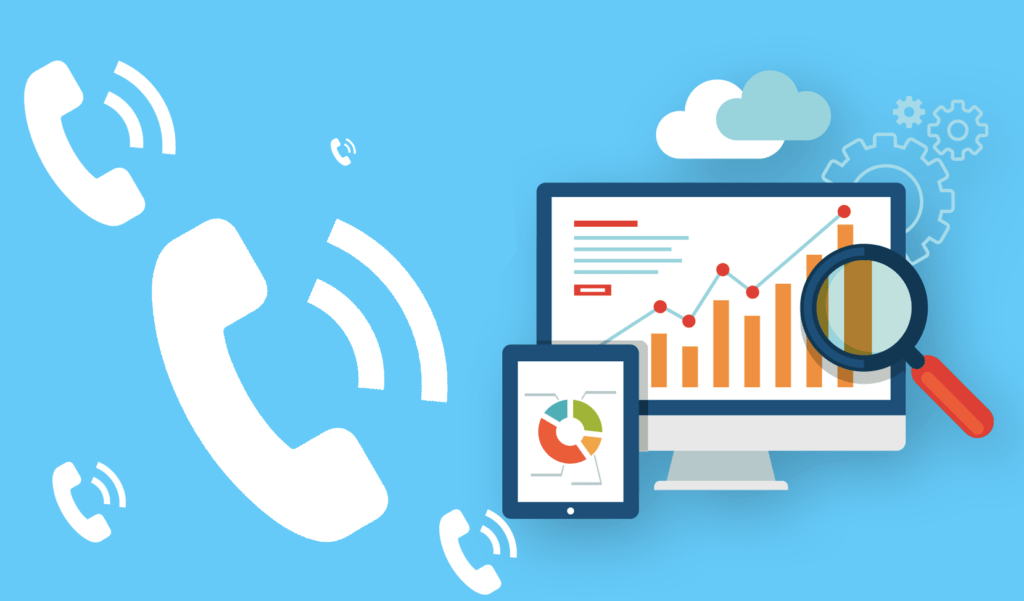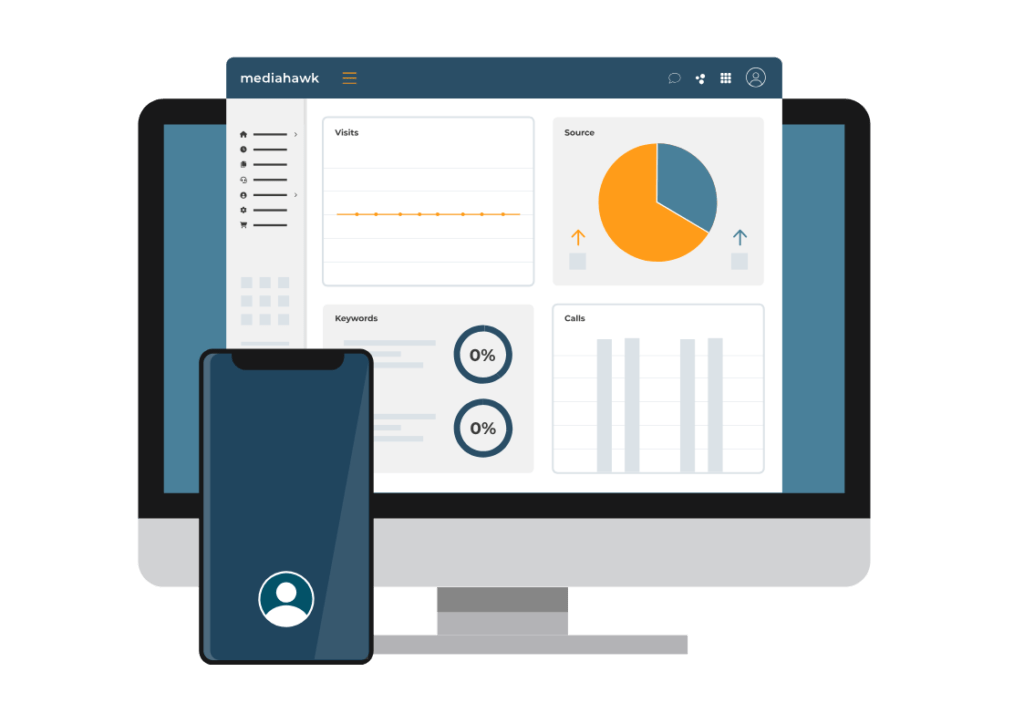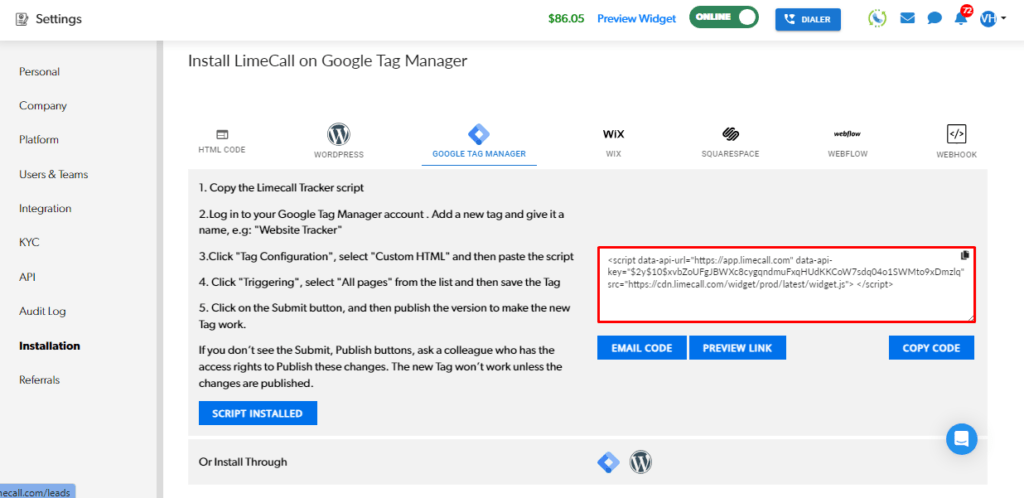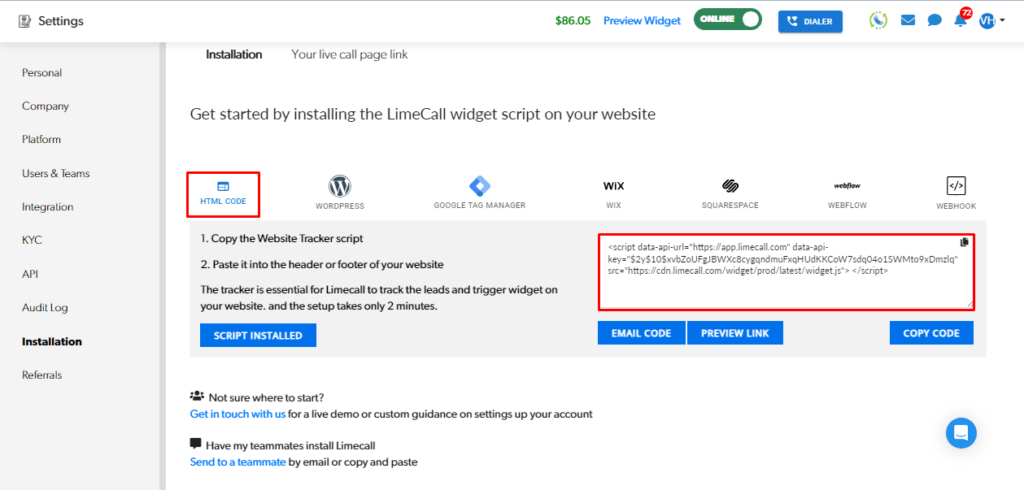Imagine a world where every phone call to your business was like a beacon, illuminating valuable insights about your marketing efforts. Sounds pretty sweet, right? Well, with call tracking, that world is closer than you think.
What Is Call Tracking?

But hold on, let’s back up. You might be asking, what exactly is call tracking? Don’t worry, LimeCall’s here to break it down. Essentially, it’s like a little detective for your phone calls. It assigns unique phone numbers to your different marketing campaigns, websites, or even offline sources. So, when a customer calls one of these numbers, the system catches details like time, duration, and even caller ID. Then, like a magic trick, it matches those details with the specific number, revealing the exact source of the call.
But it’s not just about knowing where your calls come from. Call tracking goes above and beyond, giving you:
- Actionable data: Dive deep into reports on call volume, conversion rates, and ROI for each campaign, identifying your top performers and optimizing accordingly.
- Customer insights: Analyze real conversations with call recording and transcriptions. Understand their needs, pain points, and motivations to tailor your marketing and sales strategies.
- Lead scoring: Prioritize your efforts by identifying high-value callers based on their behavior and call characteristics. Focus on the leads most likely to convert.
- Seamless call routing: Direct calls to the appropriate salesperson or department based on the source, ensuring a smooth experience for every customer.
- Unified dashboard: Integrate call tracking data with your CRM, marketing automation, and analytics platforms for a complete picture of your customer journey.
Who needs Call Tracking?
Well, pretty much any business that values phone calls, from:
- Local businesses: Track the effectiveness of online ads, website presence, and offline marketing like flyers or billboards, and pinpoint what brings in the most local love.
- E-commerce businesses: Discover which products or promotions drive phone calls and conversions, optimizing your ad spend and offerings for maximum impact.
- Agencies and marketing teams: Impress your clients with detailed reports on their campaign performance across multiple channels, proving your value and expertise.
- Sales teams: Stop guessing which leads are hot – prioritize your efforts by identifying high-value callers based on their behavior and call characteristics, closing more deals faster.
Ready to unlock the hidden potential of your phone calls Here are some key considerations before getting started:
- Budget: We offer a range of plans to fit your needs and budget.
- Technical expertise: No worries! Our setup is simple and intuitive, but we’re always here to help.
- Integrations: Connect LimeCall seamlessly with your existing tools for a smooth workflow.
Don’t let phone calls remain a mystery. Invest in call tracking and gain the insights you need to optimize your marketing, improve customer experience, and watch your business flourish.
Call Tracking Lingo – Simple Terms for Big Results
Designers know it: simplicity wins. In that spirit, let’s shed light on some common call tracking terms that might seem complex. Forget the jargon, here’s what you need to know:
Call Attribution: Imagine following a trail of footsteps. This tracks the “footprints” a caller leaves online—ads, campaigns, keywords—before reaching you. You’ll know how they found you!
Call Routing: Think of this as a smart switchboard. It connects callers to the best available agent based on what you know about them, like their interests or location.
Call Scoring: Not grading papers, but measuring operator performance. This considers problem-solving skills, protocol adherence, and even how likely they are to turn calls into sales.
Automated Call Distributor (ACD): This automated assistant follows your rules to route calls without asking the caller a single question. Think of it as a super-efficient traffic cop.
Interactive Voice Response (IVR): This friendly voice helps pre-qualify callers, gather information, and even resolve simple requests. Imagine it as a helpful receptionist before reaching a live agent.
Call Tracking Number: These unique phone numbers help you track where calls come from. Think of them as personalized invitations for different marketing campaigns, even with fun vanity numbers!
Dynamic Number Insertion (DNI): This clever technology shows different phone numbers to different callers based on criteria like location. Don’t worry, the caller only sees the number they expected, while you gain valuable data!
Now you’re equipped with clear definitions, ready to tackle call tracking with confidence. Forget impressing anyone with jargon, focus on using these concepts to understand your callers and boost your business!
How Call Tracking Works?

Understanding where your customers come from is crucial. But phone calls often remain a blind spot, leaving you wondering which marketing efforts are truly driving valuable connections. Thankfully, call tracking sheds light on this mystery, unlocking a treasure trove of insights and empowering you to optimize your marketing strategy for success.
Think of it this way: Imagine each marketing campaign has its own special ID card, encoded with valuable information about the callers it attracts. By using unique phone numbers for different campaigns, websites, and even offline sources, call tracking helps you decode this information, revealing the who, what, why, and when behind each call.
But before we dive into the nitty-gritty…
Let’s break down the basic types of call tracking:
1. Static Tracking:
- Offline: This simple approach assigns a unique number to each offline campaign (billboard, radio ad, flyer). Each call received on that number tells you which campaign brought the customer in.
- Online: Similar to offline, but for online sources like Google My Business or online listings. Track which listings drive the most calls to optimize your online presence.
2. Dynamic Number Insertion (DNI):
Take static tracking to the next level! Use a pool of numbers that dynamically change based on the visitor’s journey. For example, a visitor coming from a PPC ad might see a different number than someone browsing your website organically. This allows you to:
- Track calls to specific webpages: Identify which pages convert best into calls.
- Gain deeper insights: See keywords used, referring domains, and even visitor location for each call.
- Optimize ad campaigns: Send call data back to advertising platforms like Google Ads and Facebook for conversion tracking and improved campaign performance.
Now, let’s delve deeper into specific types of call tracking and their benefits:
3. Source Level Tracking:
- Assign unique numbers to different online sources (organic traffic, paid ads, social media) to understand which channels drive the most calls.
- Gain a detailed breakdown of each source’s performance, allowing you to allocate resources effectively and focus on your most valuable channels.
4. Session Level Tracking (DNI):
- The most advanced option, it tracks the entire visitor journey before the call. With DNI, visitors see dynamic numbers based on their behavior, allowing you to link the call to specific actions they took on your website.
- Uncover valuable insights like:
- Which landing page drove the call.
- What keywords the visitor searched for.
- Their complete page view history.
- Even record the call for detailed analysis of caller intent and needs.
The benefits of call tracking extend far beyond just identifying sources:
- Improved Customer Experience: Route calls to the most appropriate salesperson or department based on the source and caller information, ensuring a seamless experience.
- Increased Conversions: Understand caller intent and tailor your sales approach for better conversion rates.
- Optimized Marketing Spending: Allocate resources towards the campaigns that generate the most valuable calls, maximizing your marketing ROI.
Ready to unlock the power of call tracking and transform your business? Consider these factors when choosing the right solution:
- Needs and budget: Determine what level of detail you need and what your budget allows.
- Technical expertise: Choose a solution that aligns with your team’s technical capabilities.
- Integrations: Ensure it integrates seamlessly with your existing CRM, marketing automation, and analytics platforms for a holistic view of your customer journey.
By implementing call tracking, you’ll gain invaluable insights into your customers, optimize your marketing efforts, and ultimately drive more qualified leads and conversions. So, ditch the guesswork and embrace the power of call tracking – you might be surprised by the hidden gems it reveals!
Choosing the Right Number

Not all call tracking numbers are created equal. Each type offers unique advantages and disadvantages, impacting the caller experience and the data you collect. This can feel overwhelming, so let’s unpack the main types and their quirks:
| Price Per Number | Example | Target Audience | Pros | Cons | Cost for Caller | Price Per Number |
| Local | 212-555-3232 | Local area | Granular targeting & higher local conversion rates | Less appealing outside the local area | Location-based fees | Low |
| National | 888-555-3232 | Nationwide | Wide reach across the country | Less personal touch than local numbers | Standard call fees | Moderate |
| International | +1-212-555-3232 | Global audience | No geographic limitations | Higher cost & complex setup | High call fees | High |
| Toll-Free | 800-555-3232 | Customers preferring free calls | Encourages calls & builds trust | High business costs | Toll-free | Varies |
But choosing the right number isn’t just about theory. Consider real-world scenarios:
- Distracted Callers: If your target audience is often on the go, a memorable vanity number might be more effective than a standard local number.
- Brand Perception: Toll-free numbers communicate professionalism and encourage calls, but come with higher costs.
Free call tracking numbers can be a good starting point, but often have limitations on features and duration. Weigh the cost savings against the potential information you might miss.
Choosing the right number comes down to:
- Target audience: Who are you trying to reach?
- Budget: How much can you afford?
- Data needs: What information do you want to collect?
- Brand image: How do you want to be perceived?
Remember: the perfect number doesn’t exist, but understanding your options empowers you to choose the one that best serves your business goals.
Call Tracking Features

Call tracking isn’t just about gathering data; it’s about creating exceptional caller experiences. Here are some features that go beyond basic tracking to truly impress your customers:
Pre-Call Preparation:
- Call Whispers: Get ready for each call with short audio messages containing key caller information. Choose text-to-speech or upload custom recordings.
- Caller ID Display: Maintain confidentiality while instantly identifying the marketing channel that drove the call, thanks to masked caller IDs.
Streamlined Call Flow:
- Call Greetings: Keep callers engaged with professional welcome messages while they wait. Use pre-recordings or text-to-speech, customize loops, and personalize greetings.
- Keypad Entry (IVR): Empower callers with self-service options to reach the right department or information quickly, reducing wait times and frustration.
Enhanced Communication:
- Call Recordings & Transcriptions: Analyze caller interactions by reviewing clear recordings or reading convenient text transcripts. Identify top performers, coach struggling agents, and gain valuable insights.
- Call Surveys: Gather crucial real-time feedback directly after calls by prompting callers to answer key questions using their keypad.
Actionable Insights:
- Lead Scoring: Evaluate the potential of each lead with a star rating system. Take notes and automatically sync them to your CRM for seamless follow-up.
- Call Tags: Organize and categorize calls based on specific criteria for easy retrieval, analysis, and reporting.
Additional Conveniences:
- Voicemail: Handle missed calls professionally with customizable voicemail greetings and access recorded messages in your dashboard.
- Call Capping: Control call flow by setting limits on calls to specific destinations, ensuring balanced distribution and preventing overwhelmed teams.
- Email Notifications: Stay informed with real-time alerts for missed calls, voicemails, lead inquiries, and other vital activities.
- Export Leads: Easily share essential call data with colleagues and external systems by exporting leads in popular formats like XLSX, CSV, and Google Sheets.
Remember, the best call tracking solution goes beyond basic functionality. Choose features that empower you to elevate the caller experience, gain deeper insights, and optimize your entire communication strategy.
What is Offline Conversion Tracking?
Ever wondered if your online ads are actually leading to sales in the real world? The answer lies in offline conversion tracking, and it’s a game-changer for marketers.
Forget guessing! With call tracking software, you can automatically track and upload offline conversions to platforms like Google Ads, Meta Ads, and Microsoft Ads.
Why is this so important? Imagine spending a fortune on online ads, but having no clue if they’re actually bringing in customers offline. Offline conversion tracking bridges that gap, showing you how online actions translate into real-world results. Now you can:
- See which ads drive the most sales. No more wasted budget on channels that don’t deliver!
- Understand customer journeys. Know how online interactions lead to offline conversions.
- Make smarter marketing decisions. Optimize your campaigns based on actual data, not guesses.
Ready to dive deeper?
- Learn the simple setup steps: It’s all about capturing click IDs and linking them to sales data in your CRM. Easy peasy!
Want to track phone calls? No problem! Use a DNI script to create a forwarding number and identify which ads led to calls. Record calls and set duration requirements to track conversions accurately.
Don’t let your online efforts vanish into the offline void. Track your conversions, unlock powerful insights, and watch your ROI soar!
Obstacles and Essential Metrics
Embracing call tracking unlocks a goldmine of insights, empowering you to optimize your marketing strategy and turn callers into loyal customers. But let’s be honest, it’s not always smooth sailing. Here are three common hurdles you might encounter and how to overcome them:
Obstacle 1: Cost
Developing your own call tracking system can be prohibitively expensive for small and medium businesses. But fear not! Cloud-based solutions are readily available, with many providers offering affordable monthly plans (around $100) and even setup assistance.
Solution:
- Shop around: Compare features, pricing, and customer support offered by different vendors.
- Start small: Choose a basic plan that fits your current needs and budget, scaling up as your requirements evolve.
- Consider free trials: Many providers offer free trials, allowing you to test-drive the platform before committing.
Obstacle 2: Learning Curve
Call tracking might seem technically complex, requiring specialized knowledge. However, most providers understand this and offer robust support systems to help you navigate the setup and usage.
Solution:
- Leverage customer support: Don’t hesitate to reach out to the provider’s support team for assistance with setup, troubleshooting, and best practices.
- Explore resources: Many vendors offer comprehensive guides, FAQs, and video tutorials to guide you through the process.
- Start with the basics: Begin with essential features like call attribution and basic analytics. Expand your knowledge as you gain confidence.
Obstacle 3: Integration
Not all call tracking solutions seamlessly integrate with existing tech stacks. This can create data silos and hinder a holistic view of your marketing performance.
Solution:
- Prioritize integration: Before choosing a provider, ensure it integrates with your CRM, marketing automation tools, and analytics platforms.
- Ask questions: When evaluating vendors, inquire about their API capabilities and supported integrations.
- Consider customization: Some providers offer custom development options to bridge gaps between your call tracking solution and other systems.
Beyond the Obstacles: Essential Call Tracking Metrics
Once you’ve overcome these hurdles, it’s time to leverage the power of call tracking data! Here are some key metrics to monitor and analyze:
1. Call Origin:
- Identify which marketing campaigns and channels drive the most valuable calls.
- Optimize your marketing budget by allocating resources effectively.
2. Caller Location:
- Target advertising and call routing strategies based on geographic data.
- Personalize the caller experience for local calls and geo-specific products.
3. Call Length and Quality:
- Evaluate call quality using advanced features like dynamic call tracking.
- Identify and filter out spam, robot, and telemarketing calls to focus on genuine leads.
4. Visitor-to-Call Ratio (VCR):
- Pinpoint which channels generate high-intent leads versus high-volume, low-conversion calls.
- Refine your marketing efforts to attract qualified callers ready to convert.
By understanding these metrics and addressing potential obstacles, you can unlock the full potential of call tracking and transform your marketing strategy into a lead-generating powerhouse. Remember, the journey to call tracking success starts with small steps and a willingness to learn, and the rewards are well worth the effort!
Choosing Call Tracking Software

Choosing the right call tracking software can feel overwhelming. Endless options, features, and pricing models bombard you, leaving you confused and unsure. We’ll help you navigate the maze:
Know Your Needs:
- Identify Features: Do you need basic call tracking or advanced features like call recording, analytics, and IVR? Prioritize based on your current needs and future aspirations.
- Budget Wisely: Consider pricing models (per minute vs. per call) and your budget constraints. Remember, the cheapest option isn’t always the best.
Embrace Ease of Use:
- Intuitive Interface: A clunky system wastes time and increases errors. Choose software that’s user-friendly and fosters seamless navigation.
- Mobile Compatibility: If you’re on the go, ensure mobile access and functionality are available.
Integrations are Key:
- Streamline Your Workflow: Choose software that integrates with your existing CRM, marketing automation, and analytics tools. Avoid manual data entry hassles.
- Scalability: Consider integrations that support future growth and expansion.
Support Matters:
- Excellent Customer Care: When you need help, you need it fast. Choose a company with reliable and responsive customer support.
Try Before You Buy:
- Free Trials: Take advantage of free trials to test different platforms and see if they “vibe” with your business. Don’t get carried away though, stick to a few options.
Explore Further:
- Check out our article “Guide to Call Tracking for Newbies.” It offers valuable tips, with certain features like call tracking enabled in your company, you can do just that and so much more! Guiding you through how to set it up for your business.
Remember: Choosing the right call tracking software is an investment in your business growth. Prioritize features, ease of use, budget, integrations, and support to find the perfect fit and unlock actionable insights that fuel success.
5 Easy Steps: Get Started With Call Tracking
1. Find Your Perfect Match:
- Take a breath! This isn’t a blind date. With various call tracking platforms available, research and choose one that aligns with your needs and budget. Most offer free trials, so explore and find your “right fit.”
2. Grab Your Personal Calling Card:
- It’s time to choose your tracking number! Opt for one that resonates with your audience and ideally matches your existing number’s prefix for a seamless experience. Remember, this number will represent your marketing campaigns, so choose wisely!
3. Design Your Call Journey:
- Think of this as scripting a play. Decide how you want to handle incoming calls on this tracking number. Will it ring your phone directly, play a custom greeting, or route to voicemail? You’re the director, call the shots!
4. Website Magic:
- It’s time to embed the tracking magic into your website. The chosen platform will provide a code snippet. Add it to your website, and voila! Now, calls made through specific links or pages can be tracked, revealing a treasure trove of information.
5. Connect the Dots:
- Data on its own is like a puzzle with missing pieces. Connect your call tracking software to essential tools like Google Ads, Google Analytics, Meta, and your CRM. This way, call data seamlessly integrates with your existing systems, painting a complete picture of your marketing performance.
Bonus Tip: Start small and gradually expand. Begin tracking one campaign or website page, then as you get more comfortable then begin to add more numbers and features. Remember, call tracking is a journey, not a sprint.
Adding Call Tracking to Your Website (Made Easy!)

Ready to supercharge your website with the power of call tracking? LimeCall makes it incredibly simple!
Firstly, if you’re wanting to try Call Tracking for your business, Try LimeCall for FREE with our 14 Day Trial, complete with expert assistance in setting up Call Tracking.
Follow these steps to add our magic touch to your platform:
1. Grab Your LimeCall Code:
- Log in to your LimeCall account and head to the “Installation” section. There, you’ll find a handy JavaScript code snippet, ready for copy-pasting.
2. Platform Power-Up:
Now, let’s customize the experience for your website platform:
WordPress
Head to LimeCall Homepage > Settings > Installation and Click on the WordPress icon.

- In your WordPress dashboard, navigate to “Plugins” -> “Add New.”
- Search for “LimeCall” and install the plugin.
- Head to “Settings” -> “LimeCall” and paste your LimeCall code. Enjoy the tracking magic!
Google Tag Manager
Head to LimeCall Homepage > Settings > Installation and copy the code.

- Copy the Limecall Tracker script
- Log in to your Google Tag Manager account . Add a new tag and give it a name, e.g: “Website Tracker”
- Click “Tag Configuration”, select “Custom HTML” and then paste the script
- Click “Triggering”, select “All pages” from the list and then save the Tag
- Click on the Submit button, and then publish the version to make the new Tag work.
If you don’t see the Submit, Publish buttons, ask a colleague who has the access rights to Publish these changes. The new Tag won’t work unless the changes are published.
Javascript
To do this go to LimeCall Homepage > Settings > Installation and Click on the Code and copy.

- Copy the Website Tracker script
- Paste it into the header or footer of your website
- We recommend placing the code before the closing tag </body>.
The tracker is essential for Limecall to track the leads and trigger widget on your website. and the setup takes only 2 minutes.
If you need help with your Call Tracking, from Demos to Setup, reach out to our Support Team on Live Chat, support@limecall.com or visit our YouTube Channel.
Let’s Round things Up

We’ve reached the end of our epic journey. You’ve braved the technical jargon, navigated the feature forest, and emerged a true call tracking champion!
Let’s face it, even in the digital age, phones still ring. And for many businesses, those rings turn into precious sales conversations. But are you missing out on potential revenue because you can’t track where those calls come from?
Here’s where LimeCall comes in. Like a secret weapon, our call tracking software helps you identify exactly which marketing efforts are driving those valuable phone calls. No more wasted budget or resources on channels that don’t deliver.
With LimeCall, you can:
- See which campaigns, ads, and websites are generating the most calls.
- Understand your customers’ journey from online browsing to phone call.
- Optimize your marketing spend to focus on what works best.
- Turn website visitors into qualified leads and boost your bottom line.
Don’t wait another minute to unlock the hidden potential of your phone calls. Start your free LimeCall trial today and experience the difference!
Now, it’s time to put your newfound knowledge into action. Remember, call tracking isn’t just about collecting data – it’s about turning those numbers into golden insights. Analyze recordings, dig into sentiment, and use it all to understand your callers, improve your game, and personalize your approach like a boss.
Think of call tracking as your marketing secret weapon. Use it to target the right folks, optimize your campaigns like a ninja, and squeeze every drop of juice out of your marketing budget. Remember, online and offline worlds gotta hold hands, and call tracking helps bridge that gap seamlessly.
This call tracking adventure is just the beginning. Keep experimenting, exploring new features, and refining your strategy as your business grows. With each step, you’ll unlock new efficiencies, gain clarity, and watch those conversions skyrocket So, go forth, conquer those calls, and remember – we’ve got your back with tons of resources and tips. Happy tracking, and may the leads be ever in your favor!
P.S. Don’t forget to share your call tracking wins (and fails) in the comments below – we love hearing from our tracking community!


